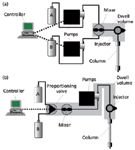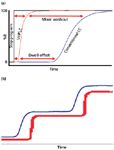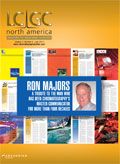Gradient Elution, Part IV: Dwell-Volume Problems
LCGC North America
How can the gradient dwell volume impact results?
Gradient methods can offer unique solutions to separation problems, but transferring a gradient method from the literature, between laboratories, or even within the same laboratory can be a challenging process.
This is the fourth installment in a series of "LC Troubleshooting" columns about gradient elution in liquid chromatography (LC). Before we started this series, we considered some techniques for using a gradient scouting run to speed the initial investigations in method development or to quickly obtain a separation under generic conditions (1). This series of column installments started with a discussion about how we could transfer our intuitive understanding of isocratic separations to gradients (2), and followed this with a way to compare isocratic and gradient methods under "equivalent" conditions (3). Last month (4), we considered some unexpected results, or surprises, that might occur if we inadvertently make changes in one gradient variable without making compensating changes in another. This month, we'll begin looking at some very practical problems related to gradient operation with a discussion of how the gradient dwell volume can impact the results.
What Is Dwell Volume?
There are two general designs of LC gradient systems, as illustrated in Figure 1. High-pressure-mixing systems (Figure 1a) generally comprise two pumps, with mobile-phase blending taking place after the pumps (in the high-pressure region). Such systems usually are limited to two solvents, although switching valves may be included that allow you to switch from one solvent to another. The other design uses low-pressure mixing (Figure 1b), in which two to four solvents are blended before they reach a single pump (mixing on the low-pressure side of the pump). The design of both system types results in a measurable volume between the point the solvents are mixed and the inlet to the column — this is the dwell volume, sometimes called the gradient delay volume. From a practical standpoint, the dwell volume is made up of two parts. The first is the physical volume of the various components, including the mixer, any connecting tubing, and usually the injection loop volume. The second is the wash-out volume, which adds to the physical volume the hydraulic characteristics of the various components, especially the mixer, to increase the effective dwell volume of the system. We'll just refer to the combined dwell volume here, although we'll touch on the wash-out volume briefly later.

Figure 1: Schematics of (a) high-pressure-mixing and (b) low-pressure-mixing LC
The Consequences of Dwell-Volume Differences
One of the biggest complaints about gradient methods is that they are hard to transfer, whether it is trying to reproduce a published method, transferring a method between laboratories, or even moving a method from one instrument to another in the same laboratory. Often the problem can be traced to differences in dwell volume between the various LC systems. This is illustrated in the simulated chromatograms of Figure 2. In each case, the same reversed-phase gradient method is run. This comprises a 10–40% B gradient (where the B-solvent is the organic solvent) in 15 min, using a 100 mm × 4.6 mm column run at 1 mL/min. We'll consider the run of Figure 2a as the reference case, where the LC system has a dwell volume of 1 mL. The peaks are all separated to baseline with a separation time of approximately 10 min. When the method is transferred to another LC system with a dwell volume of 3 mL, the chromatogram of Figure 2b results. You can see that all the peaks are shifted to longer retention times and the separation of the first two peaks suffers. This occurs even though the same gradient conditions are set in the controller.

Figure 2: The practical effect of differences in dwell volume for a 10â40% B gradient run over 15 min at 1 mL/min on a 100 mm à 4.6 mm column. Simulated chromatograms for systems with (a) 1-mL and (b) 3-mL dwell volumes; an overlay of the effective gradient is shown with each chromatogram.
The practical difference between the two methods is highlighted in the gradient overlay above each chromatogram. Although the program is set for 10–40% B in 15 min, the actual gradient that is delivered is not the same in both cases. In the first case (Figure 2a), the 1-mL dwell volume results in a 1-min delay from the time the gradient program starts until the gradient reaches the head of the column. In other words, the injection takes place 1 min before the gradient arrives at the column. This means that the sample experiences an isocratic hold for 1 min under the starting conditions. In an analogous manner, the 3-mL dwell volume of the second system (Figure 2b) adds a 3-min isocratic hold at the beginning of the gradient.
The result of the differences in dwell volume is a shifting of retention times in the chromatogram. Recall from an earlier "LC Troubleshooting" discussion (4) our oversimplified description of gradient elution: A compound sits at the top of the column until a strong enough solvent comes along to wash it off, then it travels through the column at the same rate as all other sample components. If this is true, we would expect the two chromatograms to be offset by the differences in dwell time, tD. (The dwell time is just the dwell volume, VD, divided by the flow rate, F: tD = VD/F.) In the current case, the 1-mL dwell volume system has a dwell time of tD = 1 mL/1 mL/min = 1 min, whereas the 3-mL system has tD = 3 mL/1 mL/min = 3 min. The difference in dwell times is 2 min, so we would expect a 2-min offset between chromatograms if our assumptions are true. This is what is seen for the later peaks in the two runs, as highlighted by the arrows comparing retention times between Figures 2a and 2b. However, it is a bit naive to assume that the sample components are totally unaffected by the initial conditions. This is highlighted by the shift in peak spacing (selectivity) for the first two peaks, in addition to the approximately 2-min offset. So the first two peaks of Figure 2a experience a 1-min isocratic hold at 10% B and then approximately 2 min of the gradient. In contrast, the first two peaks of Figure 2b are subjected to a 3-min isocratic hold before the gradient starts. This difference accounts for the change in selectivity that we see for the first two peaks in each run. So the primary influence of dwell-volume differences is an offset in retention time, with a secondary influence of potential changes in selectivity. It is easy to see how such differences can make it hard to transfer gradient methods between systems with different dwell volumes.
How to Measure Dwell Volume
It is important to know the dwell volume of each LC system so that we can avoid problems by compensating for differences in dwell volume when gradient methods are transferred. This measurement is illustrated in Figure 3. The setup is quite simple: Remove the column and replace it with a piece of capillary tubing. A good choice is to use approximately 1 m of 0.125-mm (0.005-in.) i.d. tubing, which provides enough back pressure to ensure that the pump check valves will work properly. Replace the A-solvent with HPLC-grade water and the B-solvent with HPLC-grade water spiked with 0.1% acetone. Use a UV detector set at 265 nm. Choose conditions that are typical of what you run in the laboratory. For example, with conventional LC systems that run 10–30 min gradients at 1–2 mL/min, a 20-min gradient at 2 mL/min is a good choice. For a system dedicated to liquid chromatography–mass spectrometry (LC–MS) or ultrahigh-pressure liquid chromatography (UHPLC), a 5-min gradient at 0.5 mL/min may be more typical. In all cases, use a gradient of 0–100% B. Most of us use the autosampler in a mode that leaves the injection loop in the flow stream during the gradient, so leave the injector in the "inject" position for this test if this is your practice. When the gradient is run, you should see a baseline trace that looks similar to that of Figure 3, rising from 0% B to 100% B over the selected gradient time.

Figure 3: Illustration of how to measure system dwell volume. See text for details.
The dwell volume can be determined in one of two ways illustrated in Figure 3. You can print the chromatogram, then draw a best-fit line through the rising baseline, as shown by the dashed line. In a similar manner, extend the initial baseline until it intersects the diagonal. This intersection should correspond to the dwell time, tD. Alternatively, perform the measurement on the computer monitor. Determine the difference in signal (offset) between the initial (0% B) and final (100% B) baselines; divide this by two to find the signal corresponding to 50% B and locate this point on the curve. Find the corresponding "retention" time, tR; this should occur halfway through the gradient, so subtract half this value (tG/2) and the remaining "retention" time will be equal to tD. For example, if a 0–100% B gradient in run in 20 min at 2 mL/min, the midpoint should be reached at 10 min into the gradient. If the midpoint of the gradient is measured as 11.2 min, then tD = 11.2 – 20/2 = 1.2 min. Convert this to the dwell volume, VD = 1.2 min × 2 mL/min = 2.4 mL.
As mentioned in the introduction, the dwell volume as well as the wash-out characteristics of a given LC system can influence the resulting chromatogram. These differences are illustrated in Figure 4a, where measurements similar to those of Figure 3 are compared for a conventional LC system and a UHPLC system. In this case, rather than a sloping gradient, a vertical step from 0 to 100% B was used. You can see that the offset between the UHPLC and LC curves is different at the beginning of the step and the end of the step. The authors (5) argue that the beginning difference corresponds to the dwell volume and the additional offset at the end represents the mixer wash-out characteristics. Thus, the wash-in and wash-out curvature is different in this case. Which measurement represents the proper dwell volume you should use when transferring a method? The choice is somewhat arbitrary, and I think that the midpoint technique used in Figure 3 is probably as good as any, unless complicated conversion procedures are used. The illustration of Figure 4b shows that dwell differences also can occur when a single system is reconfigured. Each trace represents two consecutive gradient steps in a stair-step gradient program. The same high-pressure-mixing LC system was used in each case. The upper trace represents the performance of the conventional LC system using the factory-installed mixer, generating a dwell volume measured as 2.2 mL. We modified the system for use with LC–MS by removing the original mixer and replacing it with an after-market mixer that reduced the dwell volume to 0.5 mL, with the resulting trace at the bottom of Figure 4b (the difference in line widths is an artifact of scaling to overlay the two traces). As with the two examples of Figure 4a, we see that both traces show a more rapid wash-in than wash-out and that the smaller-dwell-volume system responds much more quickly to changes in mobile-phase composition.

Figure 4: Contributions of dwell volume and wash-out volume to effective dwell volume: (a) comparison of dwell volume measured on a UHPLC and conventional LC system, adapted from reference 5; (b) comparison of same high-pressure-mixing system with two different mixers. See text for details.
Compensating for Dwell-Volume Differences
We've seen how differences in dwell volume can result in differences in the appearance of gradient chromatograms and how to measure the dwell volume. Next, let's consider how to compensate for differences in dwell volume, using the example of Figure 2. Switching from a larger-dwell to a smaller-dwell system is very simple. Just add a gradient delay (isocratic hold) corresponding to the desired additional offset. For the transfer of the method of Figure 2b to the system of Figure 2a, it would mean adding 2 min of isocratic hold to the beginning of the program. Now the program of 10/10/50% B at 0/2/17 min should give the same chromatogram as in Figure 2b with the system of Figure 2a. Of course, you could add 2 mL of volume to the system by adding a mixing coil or other modification, but this is much less convenient than adding a hold. (And it can be shown experimentally that there are slightly different results when adding an isocratic hold or a mixing coil, but these are minor in most cases.)
Transferring a gradient method from a low-dwell system to a larger-dwell system is not as simple. There are several options. First, if you are developing a new method and know that it will be used on a larger-dwell system, use the same technique mentioned above by adding an isocratic hold to the gradient program that corresponds to the additional dwell volume likely to be encountered. Then when the method is set up on a new system, the isocratic hold time (volume) can be adjusted so that the combination of the isocratic hold and the dwell volume remain unchanged between the two systems. A second technique to compensate for dwell-volume differences may or may not be available on your LC system. Many of the newer LC systems allow you to program the autosampler to inject after the gradient starts. For the present example of Figure 2b, you would program the system to inject 2 min after the gradient program is started. This would mean that the injection would take place at the same point in the gradient as it did in Figure 2a. A third technique to overcome dwell-volume differences is to over-engineer the initial separation so that a dwell-volume change is unlikely to cause problems. In the present case, the method of Figure 2a might be developed so that the first two peaks had enough excess resolution that some loss of resolution when the method is transferred will not make any difference in the analytical results. Remember that the early peaks in the chromatogram are the ones that will be most affected by dwell differences; later peaks usually are offset in time, but resolution changes are less likely. Some additional, more complex techniques are described in the literature (6), such as changing the starting %B.
Summary
We have seen that differences in system dwell volume can account for much of the difficulty encountered when transferring a gradient LC method from one system to another. A technique to measure the dwell volume of an LC system was presented. This procedure should be performed at least once on every gradient LC system so that you know its dwell volume. Several options were presented to compensate for dwell volume differences when transferring gradient methods. Because the dwell volume can be so important in gradient methods and their transfer, it should be obvious that you should list the dwell volume of the LC system as part of the method description. This will give the next user knowledge to aid in adjusting the method to get the same results on a different LC system.
Next month, we'll continue our series on gradients with a look at other common gradient elution problems.
References
(1) J.W. Dolan, LCGC North Am. 31(1), 30–35 (2013).
(2) J.W. Dolan, LCGC North Am. 31(3), 204–209 (2013).
(3) J.W. Dolan, LCGC North Am. 31(4), 300–305 (2013).
(4) J.W. Dolan, LCGC North Am. 31(5), 382–389 (2013).
(5) M. Woodman and L. Sandford, "Poster P1-G-327-MO," presented at HPLC 2011, Budapest, Hungary, 2011.
(6) L.R. Snyder, J.J. Kirkland, and J.W. Dolan, Introduction to Modern Liquid Chromatography, 3rd. ed. (Wiley, Hoboken, New Jersey, 2010).
John W. Dolan "LC Troubleshooting" Editor John Dolan has been writing "LC Troubleshooting" for LCGC for more than 25 years. One of the industry's most respected professionals, John is currently the Vice President of and a principal instructor for LC Resources, Walnut Creek, California. He is also a member of LCGC's editorial advisory board. Direct correspondence about this column via e-mail to John.Dolan@LCResources.com

John W. Dolan

Polysorbate Quantification and Degradation Analysis via LC and Charged Aerosol Detection
April 9th 2025Scientists from ThermoFisher Scientific published a review article in the Journal of Chromatography A that provided an overview of HPLC analysis using charged aerosol detection can help with polysorbate quantification.
Removing Double-Stranded RNA Impurities Using Chromatography
April 8th 2025Researchers from Agency for Science, Technology and Research in Singapore recently published a review article exploring how chromatography can be used to remove double-stranded RNA impurities during mRNA therapeutics production.










